BALI ISLAND
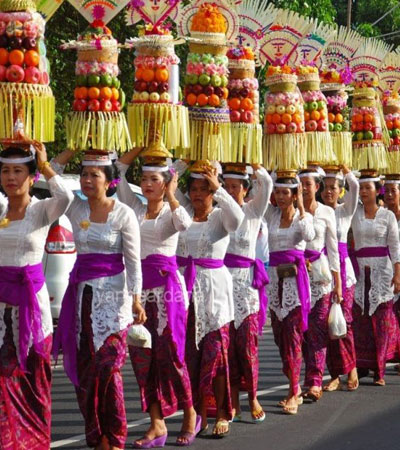
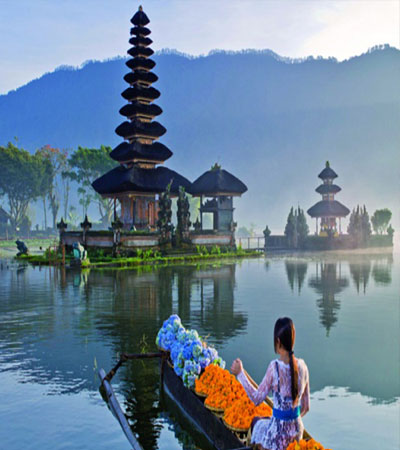
Bali
The island of Bali is just one of the thousands of island in the Indonesian Archipelago. Yet, unlike the others islands, Bali has captured the world hearts, minds, and imagination for most of this century. Bali’s allure and fascination are clear and immediate. The island is physically beautiful and the people are lithe, graceful and full of friendliness – exuding a quiet confidence. The Bali flora ranges from the humble weed flower to an extensive variety of unique orchids.
To the Balinese, the island is their entire world. Other worlds may exist outside, but theirs is complete and whole in itself. A total provider, beautiful with all the physical and spiritual attributes important to existence. In fact, the Balinese cosmos is so rich that the psychic, unseen world is constantly spilling over into the mundane. The religion of the Balinese is Hindu. Daily life is a constant, vibrant expression of need to honor, praise and appropriate the gods and nymphs, demons and witches. Hardly a day goes by without a procession or temple festival. To an outsider, Balinese life seems to be a continuous celebration with brief intervals for rest.
Bali, according to it’s most striking qualities as seen by the outsiders, has been known as “The Island of Demons,” “The Island of a Thousand Gods,” “The Last Paradise” or “The Island of a Thousand Dancers.” Some see the island as perhaps the last frontier, waiting to be discovered for its beauty, its culture, its ritualistic way of life.
Bali has often been called “The Land of Many Temples.” Temples, from small shrines in the rice fields to magnificent complexes belonging to large towns, are certainly the single most important institution on the island – and they can be seen everywhere. By the sea on desolate promontories, in caves, on the highest mountain, even entangled in the roots of banyan trees. Large and small temples appear as a natural complement to the island’s geography.
Bali is made up of eight regencies, each was once were ruled as Kingdoms.
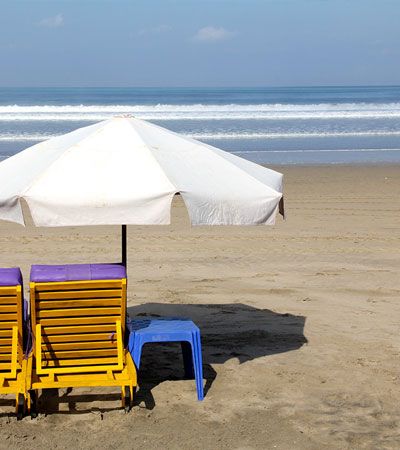
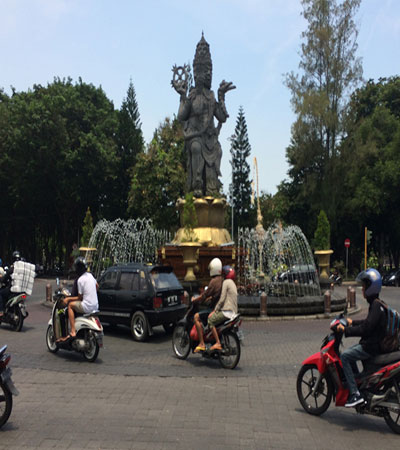
Badung
The most populous of Bali’s eight regencies, Badung comprises a narrow strip of fertile land that runs from the central mountain to the southern Bukit peninsula. This area has been the home to many of the powerful Hindu kingdoms from as far back as the 10th century. Badung today hosts the island’s major tourist resort and is Bali’s administrative center.
Kuta Bay, with its long stretch of white sand and brilliant sunsets, has attracted swarms of visitors since its “rediscovery” by shoe-string travelers in the 1970s. The town of Kuta, a former fishing village and slave market, is a booming Babylon of surfers and sun worshippers, where hundreds of hotels, bars, restaurants and souvenir shops crowd the roadside. Kuta’s tourist explosion has spilled over into the neighboring hamlets of Legian and Seminyak, where “The Legian” is located, and the southern beaches of Tuban and Jimbaran.
On Badung’s opposite coast, across the strait from Nusa Penida, are the shores of Sanur. Quieter than the Kuta area, Sanur has grown up around Bali’s largest traditional village, one that still remains administered by a priestly caste. Today, ancient shrines and the supernatural compete with water sports and souvenirs.
Denpasar, once the site of the royal court, is now a bustling market town and the provincial capital of Bali with a population of 400,000. Denpasar is an emerging Asian city and off the normal tourist track. There are a handful of temples, a bird market, the Art Centre and Museum Negeri to look through.
In contrast to the rest of the Regency, the Bukit peninsula is dry and sparsely populated. Along the beaches of Nusa Dua, however, the Indonesian Government has converted a coconut plantation into the country’s first state-run-tourism enclave.
Perched on limestone cliff 70 meters above the Indian Ocean on the Bukit’s south-east coast is Uluwatu. This 11th-century clifftop temple is one of Bali’s holiest sites and is dedicated to the spirits of the sea. It provides spectacular views and is popular for viewing sunsets.
Finally, there are the pleasure gardens and ornate sanctuaries of Mengwi, a great 18th-century kingdom that was eventually defeated and absorbed by the neighboring realms of Badung and Tabanan. The most impressive sites in this district are Temples of Taman Ayun and Sadha. Fifteen kilometers to the Northeast of present-day Mengwi village is Sangeh’s aptly name Monkey Forest and the small temple of Pura Bukit Sari. Wander through the tall nutmeg trees, but be careful, the monkeys here are notorious pickpockets!
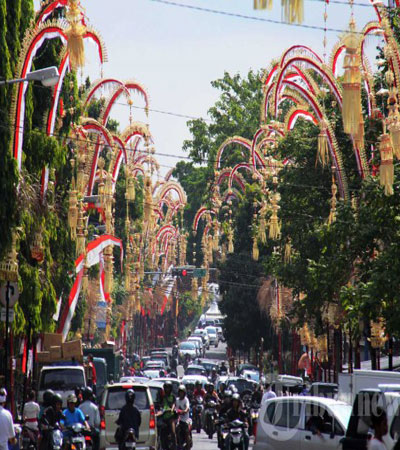
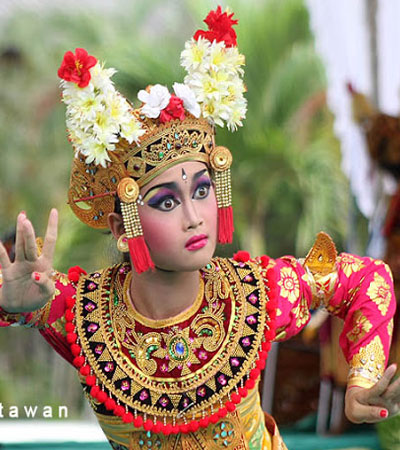
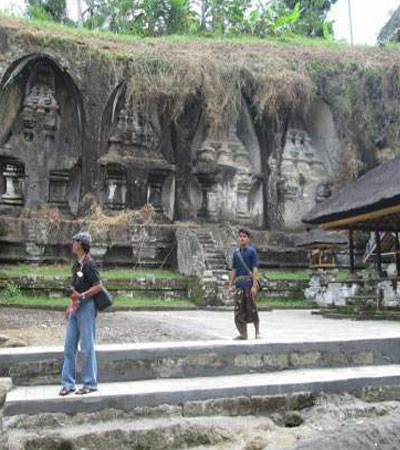
Gianyar
While the Kingdom of Gianyar was forged only in the late 18th century, this verdant territory of valleys and river-ways spawned some of Bali’s earliest settlements, Antiquities are rife here. In and around the village of Pejeng, look for the temple of Penataran Sasih – with its huge bronze kettle drum, Pusering Jagat (Navel of the World) – built in early 14th century, and Kebo Iwa – with is exotic statuary. Nearby the Archaeology Museum in Bedulu has some interesting Neolithic artifacts and stone sarcophagi.The ancient heritage of Goa Gajah (the “Elephant Cave”) is also close at hand. One of Bali’s most visited tourist sites, this complex comprises a man-made grotto, elaborate stone carvings, stupas and a number of pavilions.
Just north of Tampak Siring lies the sacred spring of Tirta Empul. Legend has it that the gods created this rejuvenating pool after their army was poisoned by the demon king Mayadenawa – it has been a holy bath since the 10th century. Nearby is Gunung Kawi (Mountain of Poets,) an 11th-century sanctuary with gurgling springs and rock-cut memorials to long-dead kings.
Gianyar is also an excellent place to shop. The highway from Batubulan to Ubud passes through a rapid succession of villages, each specializing in their own art form; be it gold and silver work, wood carving, sculpting or painting. Ubud itself, 25km north of Denpasar, has been home to craftsmen, healers, and literati for countless generations – and earlier this century become a chic retreat of foreign artists. Ubud caters to an ever-growing complement of tourist with a dozens of shops, restaurants and its own tourist information office. The museums; Neka, Puri Lukisan and Agung Rai, display fine works of modern and traditional Balinese art.
Kuta Bay, with its long stretch of white sand and brilliant sunsets has attracted swarms of visitors since its “rediscovery” by shoe-string travelers in the 1970s. The town of Kuta, a former fishing village and slave market, is a booming Babylon of surfers and sun worshippers, where hundreds of hotels, bars, restaurants and souvenir shops crowd the roadside. Kuta’s tourist explosion has split over into the neighbouring hamlets of Legian and Seminyak, where “The Legian” is located, and the southern beaches of Tuban and Jimbaran.
On Badung’s opposite coast, across the strait from Nusa Penida, are the shores of Sanur. Quieter than the Kuta area, Sanur has grown up around Bali’s largest traditional village, one that still remains administered by a priestly caste. Today, ancient shrines and the supernatural compete with water sports and souvenirs.
Denpasar, once the site of the royal court, is now a bustling market town and the provincial capital of Bali with a population of 400,000. Denpasar is an emerging Asian city and off the normal tourist track. There are a handful of temples, a bird market, the Art Centre and Museum Negeri to look through.
In contrast to the rest of the Regency, the Bukit peninsula is dry and sparsely populated. Along the beaches of Nusa Dua, however, the Indonesian Government has converted a coconut plantation into the country’s first state-run-tourism enclave.
Perched on limestone cliff 70 meters above the Indian Ocean on the Bukit’s south-east coast is Uluwatu. This 11th-century clifftop temple is one of Bali’s holiest sites and is dedicated to the spirits of the sea. It provides spectacular views and is popular for viewing sunsets.
Finally, there are the pleasure gardens and ornate sanctuaries of Mengwi, a great 18th-century kingdom that was eventually defeated and absorbed by the neighboring realms of Badung and Tabanan. The most impressive sites in this district are Temples of Taman Ayun and Sadha. Fifteen kilometers to the Northeast of present-day Mengwi village is Sangeh’s aptly name Monkey Forest and the small temple of Pura Bukit Sari. Wander through the tall nutmeg trees, but be careful, the monkeys here are notorious pickpockets!
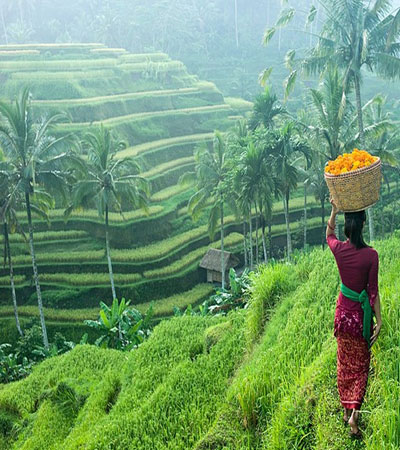
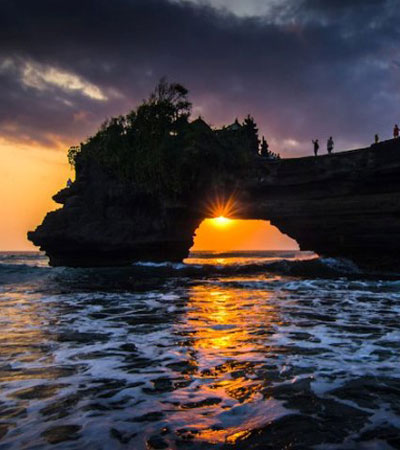
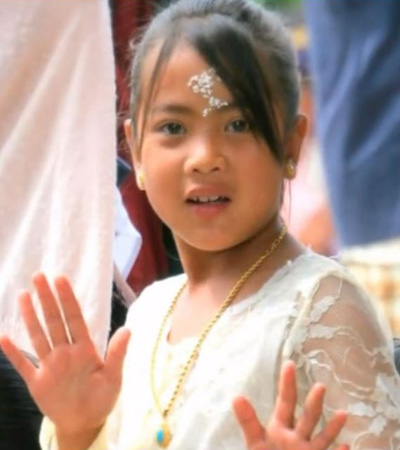
Tabanan
Sweeping down from a densely forested volcanic crest to a shoreline of long, sandy beaches and rocky outcrops, Tabanan offers a dramatic mix of terrain and landscapes. Gushing rivers and steep ravines traverse the countryside of this prosperous regency, bringing life and providing water to one of Bali’s most productive rice-growing areas. Tabanan’s most popular tourist site is Tanah Lot (“Earth from The Sea,”) a 15th-century temple built above the sea on rocky outcrop. At high tide, Tanah Lot is completely surrounded by water. There is holy spring at the outcrop’s base where poisonous sea snakes “keep guard” over the holy site from caves along the shore. Tourists, however, are no longer allowed to climb up the temple. The regency’s rugged awe-inspiring shoreline is a world apart from the cool highlands around Bedugul. Some 1,400 meters above sea level, this sleepy mountain town and the calm waters of Lake Bratan offer a welcome retreat from the heat and bustle of coastal Bali. Hike along the forested hills or stroll through the Kebon Raya Eka Karya botanical gardens.
The ancient heritage of Goa Gajah (the “Elephant Cave”) is also close at hand. One of Bali’s most visited tourist sites, this complex comprises a man-made grotto, elaborate stone carvings, stupas and a number of pavilions.
Just north of Tampak Siring lies the sacred spring of Tirta Empul. Legend has it that the gods created this rejuvenating pool after their army was poisoned by the demon king Mayadenawa – it has been a holy bath since the 10th century. Nearby is Gunung Kawi (Mountain of Poets,) an 11th-century sanctuary with gurgling springs and rock-cut memorials to long-dead kings.
Gianyar is also an excellent place to shop. The highway from Batubulan to Ubud passes through a rapid succession of villages, each specializing in their own art form; be it gold and silver work, wood carving, sculpting or painting. Ubud itself, 25km north of Denpasar, has been home to craftsmen, healers, and literati for countless generations – and earlier this century become a chic retreat of foreign artists. Ubud caters to an ever-growing complement of tourist with a dozens of shops, restaurants and its own tourist information office. The museums; Neka, Puri Lukisan and Agung Rai, display fine works of modern and traditional Balinese art.
Kuta Bay, with its long stretch of white sand and brilliant sunsets has attracted swarms of visitors since its “rediscovery” by shoe-string travelers in the 1970s. The town of Kuta, a former fishing village and slave market, is a booming Babylon of surfers and sun worshippers, where hundreds of hotels, bars, restaurants and souvenir shops crowd the roadside. Kuta’s tourist explosion has split over into the neighbouring hamlets of Legian and Seminyak, where “The Legian” is located, and the southern beaches of Tuban and Jimbaran.
On Badung’s opposite coast, across the strait from Nusa Penida, are the shores of Sanur. Quieter than the Kuta area, Sanur has grown up around Bali’s largest traditional village, one that still remains administered by a priestly caste. Today, ancient shrines and the supernatural compete with water sports and souvenirs.
Denpasar, once the site of the royal court, is now a bustling market town and the provincial capital of Bali with a population of 400,000. Denpasar is an emerging Asian city and off the normal tourist track. There are a handful of temples, a bird market, the Art Centre and Museum Negeri to look through.
In contrast to the rest of the regency, the Bukit peninsula is dry and sparsely populated. Along the beaches of Nusa Dua, however, the Indonesian Government has converted a coconut plantation into the country’s first state-run-tourism enclave.
Perched on limestone cliff 70 meters above the Indian Ocean on the Bukit’s south-east coast is Uluwatu. This 11th-century clifftop temple is one of Bali’s holiest sites and is dedicated to the spirits of the sea. It provides spectacular views and is popular for viewing sunsets.
Finally, there are the pleasure gardens and ornate sanctuaries of Mengwi, a great 18th-century kingdom that was eventually defeated and absorbed by the neighboring realms of Badung and Tabanan. The most impressive sites in this district are Temples of Taman Ayun and Sadha. Fifteen kilometers to the Northeast of present-day Mengwi village is Sangeh’s aptly name Monkey Forest and the small temple of Pura Bukit Sari. Wander through the tall nutmeg trees, but be careful, the monkeys here are notorious pickpockets!

